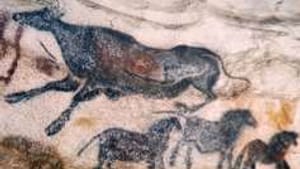Stay in the Loop
BSR publishes on a weekly schedule, with an email newsletter every Wednesday and Thursday morning. There’s no paywall, and subscribing is always free.
Why cave dwellers didn't hire interior designers
Cave dwellers, home design and the Penn Museum

My fascination with the Penn Museum— technically the University of Pennsylvania Museum of Archeology and Anthropology— began in the early 1990s, when it was still called the University Museum. In those days I was struggling with family crises and seeking periodic escape from unsolvable problems. The museum, within easy walking distance from my home in Powelton Village, became my sanctuary.
Weekdays, I would immerse myself in one ancient world or another. At my worst moments, I would check out the mummies and think how lucky I was to be alive, and still curious. After a year of these explorations, I took the museum Women's Committee trip to ancient Greece, and began to learn about the exceptional people who support this unique institution.
With more than one million artifacts collected since 1887, more than 400 research sites around the world and countless education and community outreach offerings, this museum has long been one of the world's finest archeology and anthropology institutions. Yet despite enormous promotion in recent years under director Richard Hodges, the museum remains one of Philadelphia's best kept secrets.
Although the Penn Museum's buildings on South Street take up virtually the whole block facing Penn's Franklin Field, the original late-19th-Century structure appears to be a secluded historic estate, surrounded by high brick walls and formidable iron gates. In truth those gates are open to the public. Even without entering the building, anyone can sit in the front garden and enjoy the solitude, along with golden fish flashing in their pond.
Rabid feminists
As a guest at the museum's current three-part "Beauty Through the Ages" series, my interest in the museum was reawakened, which is precisely what the museum's Women's Committee hoped it would do. Unlike the WASPish and conservative women's auxiliaries of bygone days, the high-spirited ladies on this committee are "rabid feminists with a revolutionary and evolutionary twist," as one of them— Dr. Janet M. Monge, an adjunct associate professor of anthropology— described them to me. So they have taken upon themselves the challenge of gaining recognition and funding for the Penn Museum by producing exciting educational programs while maintaining the highest academic standards.
After attending the first program in the "Beauty" series— "Jewelry: Worn to Adorn"— I was drawn to "Home Décor: From Cave to Castle" last month. As an interior designer, I was especially intrigued when the keynote speaker, Dr. Monge, informed us that scientists have found conclusive evidence that cavemen didn't actually live in the deep recesses of their caves, where all those extraordinary painted animal murals have been found.
Instead, she said, cave people of 25 to 30 millennia ago cooked, slept and carried on their family lives in the outer caverns. They may have been great artists, but their own living quarters were unadorned.
Survival trumps all
At first I was dismayed by this development. Like many other wishful-thinking designers, I've always assumed that, as Sherrill Whiton wrote in Interior Design and Decoration (1974), "The origin of the art of interior design can be dated from the dawn of human civilization and is an integrated part of human needs."
Yet according to Dr. Monge, there is no evidence that early cave people were engaged in home decoration. Presumably because they were preoccupied 24/7 with survival, what mattered to them was function, not form. (The superb murals they painted deep in the caves served some other unknown purpose, perhaps religious.)
What are the implications for designers like me, who believe the home should be treated as a work of art? After mulling this over with Monge, as well as with Susan Washburn, another anthropologist who is also a professional interior designer, I've concluded that residential designers shouldn't rely on history or anthropology to validate our valuable work.
Linking ourselves with cave people does our field no more good than does, say, status seeking by association with monarchs and movie stars— a commonplace design promotion ploy.
"'Man cave' jokes
In countless ways, the home is a profoundly important center in human lives. Consequently, design professionals like me need to pay more attention to developing personal environments, basic aesthetics and all varieties of human comforts— even including safe havens such as the much ridiculed "man caves" and women's boudoirs.
Besides, just because the outer cave rooms held no evidence of wall drawings or paintings, that doesn't necessarily mean that Cro-Magnon artists failed to decorate their actual homes. In my experience, skilled and inspired artists rarely confine themselves to their studios; sooner or later they start making art at home.
The cave dwellers of 25,000 years ago actually painted each other generously. They also designed and wore fabulous jewelry. Motifs from their necklaces, bracelets and rings are still copied today. They used animal hides and furs for clothes and beds.
Also, the fact that no wall art works have been discovered in the outer caves doesn't necessarily mean there were none; those spaces were vulnerable to sun and rain, not to mention robbers of all sorts. Only the deeper unlivable recesses of the caves were capable of preserving art. (When I bounced this possibility off Dr. Monge, she agreed.)
The principal goals of interior design are beauty, comfort, efficiency and personal style. There's reason to believe that in their own way, the cave dwellers— not to mention the ancient Egypt and Greeks— strove for all four. I plan to continue researching the origins of genuine human homes in the hope of finding lessons I can apply to contemporary homes. The good news is: I can conduct most of my research without leaving my own West Philadelphia neighborhood.♦
To read responses, click here.
Weekdays, I would immerse myself in one ancient world or another. At my worst moments, I would check out the mummies and think how lucky I was to be alive, and still curious. After a year of these explorations, I took the museum Women's Committee trip to ancient Greece, and began to learn about the exceptional people who support this unique institution.
With more than one million artifacts collected since 1887, more than 400 research sites around the world and countless education and community outreach offerings, this museum has long been one of the world's finest archeology and anthropology institutions. Yet despite enormous promotion in recent years under director Richard Hodges, the museum remains one of Philadelphia's best kept secrets.
Although the Penn Museum's buildings on South Street take up virtually the whole block facing Penn's Franklin Field, the original late-19th-Century structure appears to be a secluded historic estate, surrounded by high brick walls and formidable iron gates. In truth those gates are open to the public. Even without entering the building, anyone can sit in the front garden and enjoy the solitude, along with golden fish flashing in their pond.
Rabid feminists
As a guest at the museum's current three-part "Beauty Through the Ages" series, my interest in the museum was reawakened, which is precisely what the museum's Women's Committee hoped it would do. Unlike the WASPish and conservative women's auxiliaries of bygone days, the high-spirited ladies on this committee are "rabid feminists with a revolutionary and evolutionary twist," as one of them— Dr. Janet M. Monge, an adjunct associate professor of anthropology— described them to me. So they have taken upon themselves the challenge of gaining recognition and funding for the Penn Museum by producing exciting educational programs while maintaining the highest academic standards.
After attending the first program in the "Beauty" series— "Jewelry: Worn to Adorn"— I was drawn to "Home Décor: From Cave to Castle" last month. As an interior designer, I was especially intrigued when the keynote speaker, Dr. Monge, informed us that scientists have found conclusive evidence that cavemen didn't actually live in the deep recesses of their caves, where all those extraordinary painted animal murals have been found.
Instead, she said, cave people of 25 to 30 millennia ago cooked, slept and carried on their family lives in the outer caverns. They may have been great artists, but their own living quarters were unadorned.
Survival trumps all
At first I was dismayed by this development. Like many other wishful-thinking designers, I've always assumed that, as Sherrill Whiton wrote in Interior Design and Decoration (1974), "The origin of the art of interior design can be dated from the dawn of human civilization and is an integrated part of human needs."
Yet according to Dr. Monge, there is no evidence that early cave people were engaged in home decoration. Presumably because they were preoccupied 24/7 with survival, what mattered to them was function, not form. (The superb murals they painted deep in the caves served some other unknown purpose, perhaps religious.)
What are the implications for designers like me, who believe the home should be treated as a work of art? After mulling this over with Monge, as well as with Susan Washburn, another anthropologist who is also a professional interior designer, I've concluded that residential designers shouldn't rely on history or anthropology to validate our valuable work.
Linking ourselves with cave people does our field no more good than does, say, status seeking by association with monarchs and movie stars— a commonplace design promotion ploy.
"'Man cave' jokes
In countless ways, the home is a profoundly important center in human lives. Consequently, design professionals like me need to pay more attention to developing personal environments, basic aesthetics and all varieties of human comforts— even including safe havens such as the much ridiculed "man caves" and women's boudoirs.
Besides, just because the outer cave rooms held no evidence of wall drawings or paintings, that doesn't necessarily mean that Cro-Magnon artists failed to decorate their actual homes. In my experience, skilled and inspired artists rarely confine themselves to their studios; sooner or later they start making art at home.
The cave dwellers of 25,000 years ago actually painted each other generously. They also designed and wore fabulous jewelry. Motifs from their necklaces, bracelets and rings are still copied today. They used animal hides and furs for clothes and beds.
Also, the fact that no wall art works have been discovered in the outer caves doesn't necessarily mean there were none; those spaces were vulnerable to sun and rain, not to mention robbers of all sorts. Only the deeper unlivable recesses of the caves were capable of preserving art. (When I bounced this possibility off Dr. Monge, she agreed.)
The principal goals of interior design are beauty, comfort, efficiency and personal style. There's reason to believe that in their own way, the cave dwellers— not to mention the ancient Egypt and Greeks— strove for all four. I plan to continue researching the origins of genuine human homes in the hope of finding lessons I can apply to contemporary homes. The good news is: I can conduct most of my research without leaving my own West Philadelphia neighborhood.♦
To read responses, click here.
What, When, Where
"Beauty Through the Ages." Final program April 17, 2012 at University of Pennsylvania Museum of Archeology and Anthropology. 3260 South St. (215) 898-4000 or www.penn.museum.
Sign up for our newsletter
All of the week's new articles, all in one place. Sign up for the free weekly BSR newsletters, and don't miss a conversation.

 Caroline Dunlop Millett
Caroline Dunlop Millett